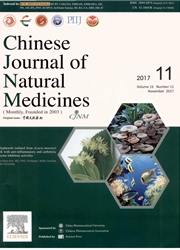

 中文摘要:
中文摘要:
In the present study, two new limonoids, 1α, 7α-dihydroxyl-3α-acetoxyl-12α-ethoxylnimbolinin(1) and 1α-tigloyloxy-3α-acetoxyl-7α-hydroxyl-12β-ethoxylnimbolinin(2), together with other four known limonoids(3-6), were isolated from the fruits of Melia toosendan. Their structures were elucidated by means of extensive spectroscopic analyses(NMR and ESI-MS) and comparisons with the data reported in the literature. The isolated compounds were evaluated for their antibacterial activities. Compound 4 exhibited significant antibacterial activity against an oral pathogen, Porphyromonas gingivalis ATCC 33277, with an MIC value of 15.2 μg·m L-1. Compound 2 was also active against P. gingivalis ATCC 33277, with an MIC value of 31.25 μg·m L-1. In conlcusion, our resutls indicate that these compounds may provide a basis for future development of novel antibiotics.
 英文摘要:
英文摘要:
In the present study, two new limonoids, 1α, 7α-dihydroxyl-3α-acetoxyl-12α-ethoxylnimbolinin(1) and 1α-tigloyloxy-3α-acetoxyl-7α-hydroxyl-12β-ethoxylnimbolinin(2), together with other four known limonoids(3-6), were isolated from the fruits of Melia toosendan. Their structures were elucidated by means of extensive spectroscopic analyses(NMR and ESI-MS) and comparisons with the data reported in the literature. The isolated compounds were evaluated for their antibacterial activities. Compound 4 exhibited significant antibacterial activity against an oral pathogen, Porphyromonas gingivalis ATCC 33277, with an MIC value of 15.2 μg·m L-1. Compound 2 was also active against P. gingivalis ATCC 33277, with an MIC value of 31.25 μg·m L-1. In conlcusion, our resutls indicate that these compounds may provide a basis for future development of novel antibiotics.
 同期刊论文项目
同期刊论文项目
 同项目期刊论文
同项目期刊论文
 期刊信息
期刊信息
